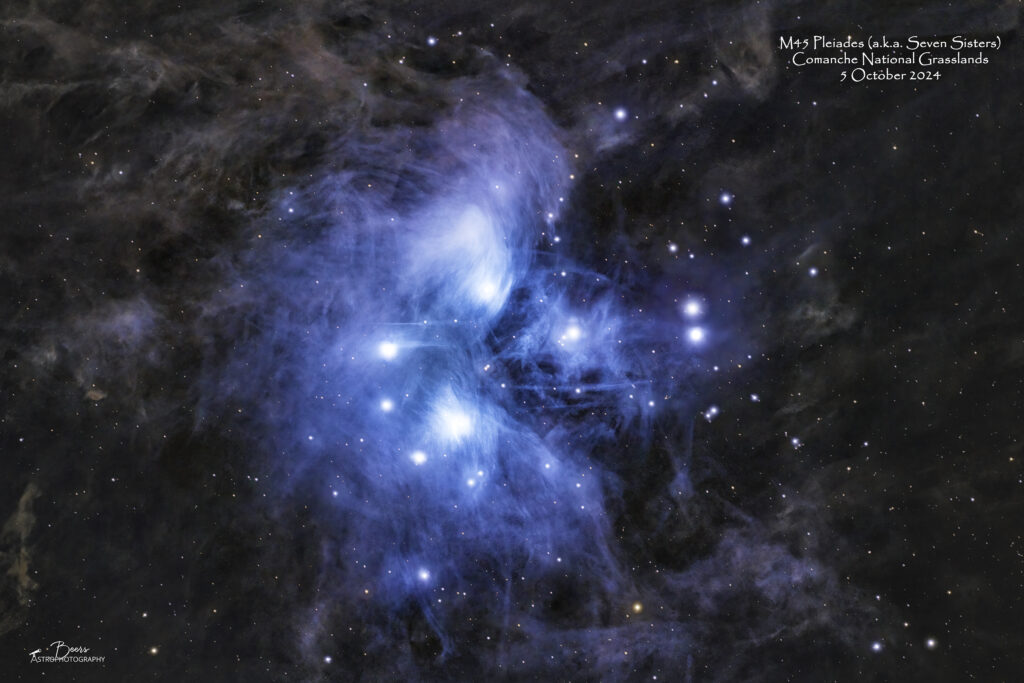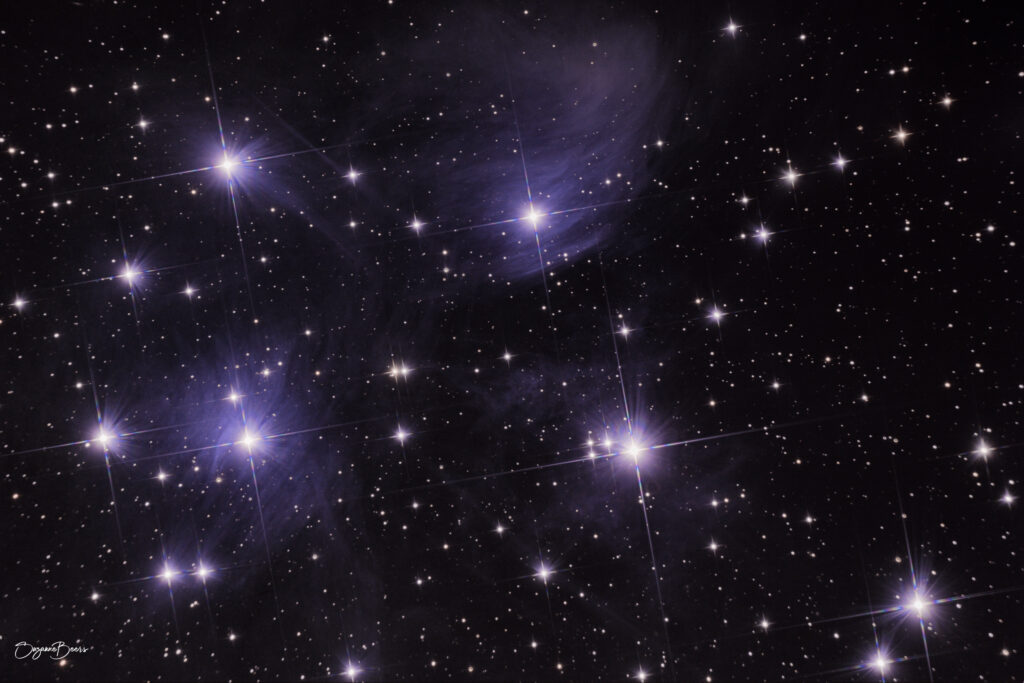
Target fun facts
The Pleiades also known as The Seven Sisters, Messier 45 and other names by different cultures, is an asterism and an open star cluster containing middle-aged, hot B-type stars in the northwest of the constellation Taurus. At a distance of about 444 light years, it is among the nearest star clusters to Earth. It is the nearest Messier object to Earth, and is the most obvious cluster to the naked eye in the night sky. It is also observed to house the reflection nebula NGC 1432, an HII region.
The cluster is dominated by hot blue luminous stars that have formed within the last 100 million years. Reflection nebulae around the brightest stars were once thought to be left over material from their formation, but are now considered likely to be an unrelated dust cloud in the interstellar medium through which the stars are currently passing. This dust cloud is estimated to be moving at a speed of approximately 18 km/s relative to the stars in the cluster.
Computer simulations have shown that the Pleiades were probably formed from a compact configuration that resembled the Orion Nebula. Astronomers estimate that the cluster will survive for about another 250 million years, after which it will disperse due to gravitational interactions with its galactic neighborhood.
Together with the open star cluster of the Hyades, the Pleiades form the Golden Gate of the Ecliptic.
Origin of name: The name, Pleiades, comes from Ancient Greek: Πλειάδες. It probably derives from plein (“to sail”) because of the cluster’s importance in delimiting the sailing season in the Mediterranean Sea: “the season of navigation began with their heliacal rising”. In Classical Greek mythology the name was used for seven divine sisters called the Pleiades. In time, the name was said to be derived from that of a mythical mother, Pleione, effectively meaning “daughters of Pleione”. In reality, the ancient name of the star cluster related to sailing almost certainly came first in the culture, naming of a relationship to the sister deities followed, and eventually appearing in later myths, to interpret the group name, a mother, Pleione.
Astronomical role of M45 in antiquity: The M45 group played an important role in ancient times for the establishment of many calendars thanks to the combination of two remarkable elements. The first, which is still valid, is its unique and easily identifiable appearance on the celestial vault near the ecliptic. The second, essential for the ancients, is that in the middle of the third millennium BC, this asterism (a prominent pattern or group of stars that is smaller than a constellation) marked the vernal point.
Other Catalog Designations: Seven Sisters, M45, Cr 42, Mel 22
Subtype: Open Cluster
Distance from Earth: 444 ly on average (136.2±1.2 pc)
Apparent Size: 2°
Size: 20.34 light years (radius)
Magnitude: 1.6
Constellation: Taurus
{Target information derived from: https://en.wikipedia.org/wiki/Pleiades}
Capture & processing notes
M45 Pleiades was the second target for the Southern Cross on our first night at the Comanche National Grasslands Camel Rock camping site during our October dark skies trip.
The night was quite windy, causing power issues with the Southern Cross, which was connected to the cigarette lighter plug that Paul had installed drawing power from the vehicle’s battery. The connection has never been very secure. I didn’t realize that the wind would have such a deleterious effect on it. When I came out to change Southern Cross targets (from SH2-157 to M45) at about 00:30MDT, I discovered that while the mount was still powered and tracking, the laptop had shut down and would not recognize that it was plugged in. Before starting up again on the second target (M45), I connected a DC extension cable to the Beast’s back-end power outlet (which up to this point had been a more reliable connection than the front-end battery connection). That worked until it didn’t! Something terminated the M45 Pleiades sequence at 0322MDT when the autoguider lost its guide star. I haven’t dug into the logs to see if I can get more details on exactly what happened – but it was likely the wind wreaking havoc on either the power connection or the autoguider.
I also discovered when I polar aligned the equipment on the second night, that it was out of alignment more than the settling overnight would account for – so all the images captured during the first night on both rigs have a substantial amount of star trails and the autoguider struggled with very poor performance.
In processing M45, I would have preferred to have the star diffraction spikes that imaging with Big Bertha would have (and has in the past) created. I spent quite a bit of time trying to combine these data with old data captured with Big Bertha, artificially adding the star diffraction spikes with the Photoshop Astronomy Tools action toolkit. All ended up making a mess or looking very fake – so the image is as the Southern Cross captured it.
Sequence Plan (5Oct2024): Gain: 158, Temp: -0°C, offset=30. 35x300sec. Total: 175 minutes (2:55 hours). Captured 6Oct2024, 00:45MDT – 6Oct2024, 03:22MDT.
Processing: Captured in SGP, stacked in APP (Adaptive Airy Disc), star removal with Starnet++, processing with LR/PS
Equipment
All equipment controlled by HP Probook running Sequence Generator Pro v4.4.1.1441.
- Imaging (ASI2400-SC): ZWO ASI2400MC imaging camera on (Southern Cross) Askar FRA600 108mm f/5.6 Quintuplet Petzval Flat-Field Astrograph
- Autofocuser: ZWO EAF Electronic Automatic Focuser (EAF-5V-STD)
- Mount: Rainbow Astro RST-135E (controlled by iHubo ASCOM driver)
- Polar alignment: QHYCCD camera (controlled by Polemaster for polar alignment)
- Autoguiding: Orion 60mm Multi-Use Guide Scope with Orion StarShoot AutoGuider Pro Mono Astrophotography Camera (controlled by PHD2)
Summary
Capture: 5 October 2024, Total data capture: 2:55 hours
Equipment: Southern Cross
Shooting location: Comanche National Grasslands’ Camel Rock, Colorado
Processing: Captured in SGP, stacked in APP (Adaptive Airy Disc), star removal with Starnet++, processing with LR/PS
Other images of M45 Pleiades

Capture Notes
Captured with Big Bertha and the Canon EOS Ra from the dark skies of Mills Canyon, Kiowa National Grasslands, New Mexico.
Equipment
Polar alignment: QHYCCD camera (controlled by Polemaster)
Imaging stream: Orion 8″ f/8 Ritchey-Chretien Astrograph Telescope, Canon EOS Ra
Mount: Sky-Watcher EQ6-R Pro Equatorial Mount (controlled by EQMOD)
Autoguider: Orion 60mm Multi-Use Guide Scope, Orion StarShoot AutoGuider Pro Mono Astrophotography Camera (controlled by PHD2)
All equipment controlled by HP Probook running Sequence Generator Pro v3.2.0.660.
Capture & processing notes
Sequence plan: ISO800, 49x60sec + 50x180sec + 20x300sec
Capture: 8 September 2021
Shooting location: Mills Canyon, Kiowa National Grasslands, New Mexico
Processing: Stacked in Deep Sky Stacker (DSS), processed in LR/PS.
